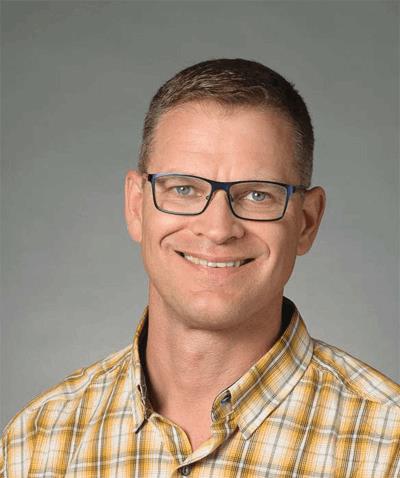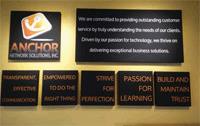Inside The Mind Of A Business-Savvy MSP
By The Business Solutions Network
This MSP’s commitment to ongoing learning and operational efficiency is leading to continued double-digit growth.

After reading The Pumpkin Plan by Mike Michalowicz, Anchor Network Solutions’ CEO, Vince Tinnirello, started evaluating his customers more closely, assigning each one a letter grade and “weeding out” the low performers.
It was just over three years ago when I first met Vince Tinnirello, CEO of managed services provider Anchor Network Solutions. At the time, the $2 million MSP had 13 employees and had increased its revenue 13 percent in 2013, and the company was projecting 16 percent revenue growth in 2014. Tinnirello boiled his success down to four key drivers:
1. Hone your MSP bedside manners. This one comes down to hiring technicians who have a deep knowledge of technology, but at the same time can speak about IT matters to non-IT people in a clear and helpful manner. Considering the fact that 80 percent of the MSP’s revenue comes from consulting services and only 20 percent comes from selling hardware or software, Tinnirello’s commitment to communication makes a lot of sense.
2. Maintain transparency with customers. This principle can be seen in Anchor Network Solutions’ decision to not white-label any products, which entails removing the manufacturer’s stickers or signage and replacing it with one’s own name and logo. The MSP’s approach to selling BDR (backup and disaster recovery) is another area where its transparency policy is highlighted. Before signing a BDR contract, the MSP explains to the client that part of the reason it uses higher-end BDR solutions is that they are more reliable and will cut down on the MSP’s labor costs, too.
3. Lower the barrier of entry to do business with your company. Instead of trying to lock customers into three-year contracts, Anchor Networks prefers one-year contracts with a 30-day out clause so that clients feel like working with the MSP is a low-risk proposition instead of a gamble.
4. Let KPIs (key performance indicators) be your guide. While every MSP likes to focus on profits, Anchor Network Solutions uses its PSA (professional services automation) tool to also keep track of a variety of other business activities, including the specific time it takes to perform installs, services, and labor activities. Having this level of granularity allows the MSP to know the true cost of everything it sells, which is invaluable info to have when it comes to establishing — and raising — prices.
I caught up with Tinnirello recently and was curious to find out how his business had grown and evolved in the past three years. Not surprisingly, his company continues to post healthy double-digit revenue growth numbers. During our conversation, I learned a few secrets to Anchor Network Solutions’ success that I hadn’t discovered previously. The biggest revelation was his passion for ongoing learning.
Last year, for example, he attended two keynote presentations on IT customer service given by Don Crawley, author of The Compassionate Geek. Afterwards, he purchased a copy of Crawley’s book for each staff member, and once a week the company met and discussed a chapter of the book. After completing the book several weeks later, Tinnirello hired the author to deliver a oneday, comprehensive customer service training program for his staff at Anchor Network Solutions’ headquarters in Denver. “Many people think that effective communication is merely the delivery of information,” says Tinnirello. “How the information is presented and received are also important components that shouldn’t be overlooked. For example, sometimes a technician feels like they’ve done their job after notifying a client that they are going to take down its network. But, if the person who was notified fails to pass along the message, it creates a breakdown in communication that ultimately reflects poorly on our company. In these situations, good communication may require our technician to notify several contacts within an organization and to send one or two reminders before servicing the network.” After completing the book and training session, Tinnirello says several of his employees thanked him for the experience. “That was one of the best things I’ve done for my business in a long time,” he says.
Throughout our conversation, he shared several new activities he was doing to build upon his previous success, and, in nearly every instance, he referenced a bestselling business book as the impetus. In addition to The Compassionate Geek, other books that have played a key role in shaping the MSP’s business thinking include:
1. The Five Dysfunctions Of A Team by Patrick Lencioni. This book was recommended by Tinnirello’s peer group, MSP Ignite. It describes the many pitfalls teams face as they strive to work together. The author reveals the basics of teamwork by using a leadership fable, a story of a technology company that is struggling to grow and find customers. As the story progresses, the five dysfunctions are revealed: absence of trust, fear of conflict, lack of commitment, avoidance of accountability, and inattention to results. Lencioni’s overarching philosophy aligns nicely with Tinnirello’s. “Successful teamwork is not about mastering subtle, sophisticated theories, but rather about combining common sense with uncommon levels of discipline and persistence,” says the author. “Ironically, teams succeed because they are exceedingly human. By acknowledging the imperfections of their humanity, members of functional teams overcome the natural tendencies that make teamwork so elusive.”
2. The Checklist Manifesto: How To Get Things Right by Atul Gawande. In the increasingly complex world we live in, the author, who is also an acclaimed surgeon, finds a remedy in the simplest of techniques: the checklist. “It’s about the importance of operational efficiency,” says Tinnirello, a concept he’s quite passionate about. “When I started the company as a one-man show 15 years ago, the IT landscape was much simpler. I’d meet with each client, sit down with each user, and talk about their computers and software. If there were any unnecessary apps, I’d open the add/remove apps program and get rid of everything that wasn’t needed, one at a time. Nowadays, each customer has exponentially more apps, plus they have more computers and networking gear, and everything has to be well-documented and automated for us to be able to manage it properly. The Checklist Manifesto shares several examples in aviation and healthcare where pilots and surgeons rely on detailed checklists to perform mission-critical tasks day after day and year after year with few errors. One of our top goals for 2017 is to become more checklist-driven so we can provide our customers with a more consistent experience. The idea is that whenever a customer calls our company, no matter who answers the call, the customer receives the same high-quality service.”
Tinnirello notes, however, that becoming operationally efficient doesn’t mean running too lean with his staffing. “I try to always have one extra service desk person at all times,” he says. “There are a couple of reasons for this. First, it allows me to get my staff involved in activities beyond just watching metrics, such as pursuing a new technology interest, certification, or business skill. It also enables me to deal with terminations from a position of power, rather than going into a state of panic anytime someone leaves the company.”
3. The Pumpkin Plan by Mike Michalowicz. As the name implies, the author looks at the seven steps prize-winning pumpkin growers follow (i.e., plant promising seeds, add water, remove diseased/damaged pumpkins, pull out the weeds, keep only the best pumpkin on each vine, nurture it, and watch it grow). And he parallels these steps to the seven steps necessary for growing a successful business (i.e., identify your biggest strengths, sell, fire small-time clients, weed out distractions, remove lesspromising clients, focus on top clients, watch your company grow). Since reading the book, Tinnirello says he’s become more mindful of evaluating his customers. “It’s not just about looking at how much each client spends, but we look at other factors like which customers we enjoy working with,” he says. “Do they value technology? Do they value us? Does our staff like picking up the phone when they call? Do they communicate effectively?” After going through an evaluation checklist, each client receives a grade, A through F. In some cases, the exercise helps the MSP take actions to improve the relationship, but in others, it’s an eye-opener that it may be time to part ways. “No matter how much effort you put into some clients, the mutual respect and commitment to communications just isn’t there,” says Tinnirello. “If it gets to that point, it may be time to send them a friendly termination letter and off-board them in a professional manner.”
4. Traction: Get A Grip On Your Business by Gino Wickman. This Amazon bestseller focuses on five common frustrations most entrepreneurs face, including: lack of control, people problems, slim profit margins, business stagnation, and the “nothing’s working” syndrome. The author reminds business owners, “You are not your business; your business is an entity in and of itself.” Although the entrepreneur creates the business, in order to find success, the business must be turned into a self-sustaining organism. Reaching that next level requires more than just adding a new product or service. It takes skills, tools, and a systematic approach to optimize people, processes, execution, management, and communication. Wickman offers his Entrepreneurial Operations System (EOS) as a means to address the five common frustrations and help entrepreneurs gain traction in their businesses.
Despite his company’s strong business focus, Tinnirello says Anchor Network Solutions is also very much focused on keeping up with new technologies that will play key roles in his company’s growth. One area in particular where the MSP expects to see new growth in the near future is security. “The threat landscape has become a huge concern for our customers, and traditional firewalls and antivirus software alone don’t offer adequate protection,” he says. “We’re in the process of formalizing our security offering and providing security monitoring services to our customers. This will be especially important for customers in highly regulated industries that have to meet PCI or HIPAA requirements. In the past, it would have been impossible for an SMB to afford a high-end security offering like SIEM [security information and event management], which requires a dedicated SOC [security operation center]. But, with the progress of the cloud and the as-a-Service business model, IT solutions and services once reserved for large enterprises are available to smaller businesses as well. And it’s a good thing because whether a business is big or small — they’re equally fair game to cybercriminals.”

